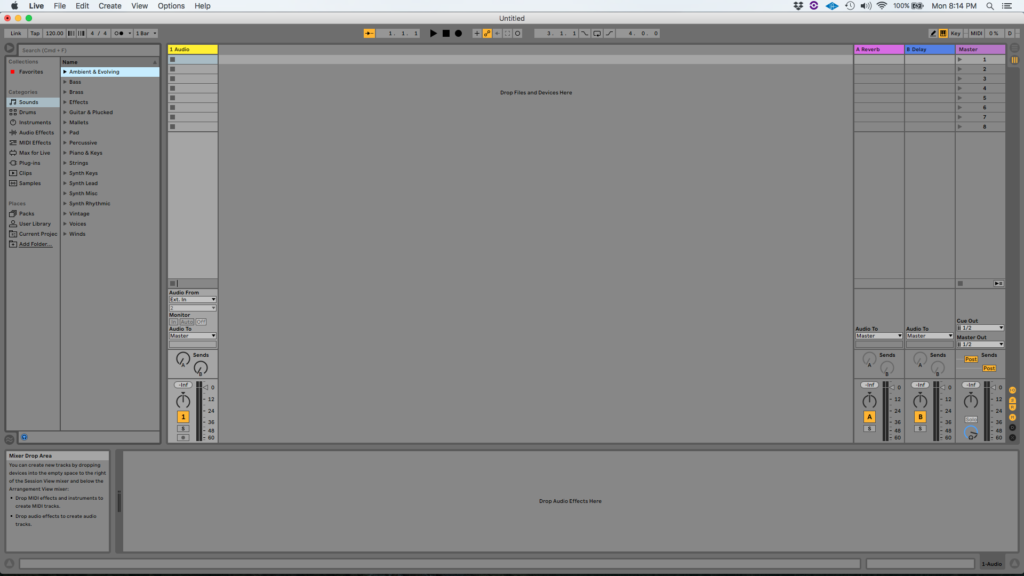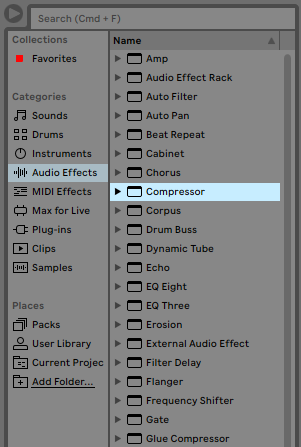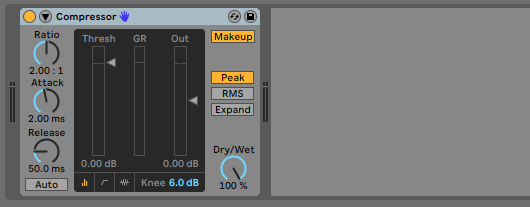This tutorial shows the user how to use the Ableton Live COMPRESSOR audio effect.
Need a Pro Audio laptop to run Ableton Live software and all of its features at its best? Check out the MC Mobile line of Pro Audio Laptops from PCAudioLabs.
On the modern days of audio mixing, the digital tools that engineers use in order to shape the recorded sound are called Plugins. Plugins can emulate the behavior of vintage analog pieces of gear, or simply act as clean/linear digital signal processors, performing tasks such as equalization, compression, limiting, expansion, gating, time-domain effects, etc. Ableton Live comes with a variety of proprietary plugins (effects) that can help the user mix a music production completely “in-the-box”.
One of the most used inserts that come with Ableton Live is the Compressor, which can be defined as a device that affects the dynamic range of a signal by bringing down the level of the loudest parts, making the loud and quiet parts closer together in volume, ultimately yielding volume differences that are less obvious.
For the purpose of this tutorial, we will explain how to use the Compressor audio effect in Ableton Live 10:
- Create a Live Set with at least one audio track. Make sure the audio track has at least one audio clip assigned to it.
2. From the Browser, search for Audio Effects -> Compressor:
3. Drag and Drop the Compressor audio effect on top of the audio track labeled as “1 Audio”.
As soon as this effect has been dropped on top of the track, it is easy to see how the Compressor audio effect now appears on the device view of the track.
It is easy to see from the previous picture, the Compressor audio effect has several parameters that can be explained as:
- Ratio: This knob sets the ratio of compression between the input and the output.
- Attack: This knob sets how long it takes to reach maximum compression after the signal exceeds the threshold.
- Release: This knob sets how long it takes compression to stop after the signal has fallen below the threshold.
- Auto: When this option is engaged, the attack and release times are automatically adjusted based on the incoming audio signal.
- Threshold: Sets the input level at which the compression will start.
- GR: This meter shows the amount of gain reduction applied by the compressor.
- Out: This knob sets the amount of gain applied to the signal after compression.
- Show options:
- Show collapsed view: Compressor only shows the most essential parameters.
- Show Transfer Curve view: Compressor will show an Input/Output transfer curve.
- Show Activity view: Useful for visualizing what happens with the signal over time.
- Knee: This control adjusts how quickly the compressor responds as the input level approaches the threshold.
- Lookahead: This control sets the amount of time that the input signal will be delayed.
- Linear/Log Release: This control toggles the compression release between linear and logarithmic.
- Makeup: When this is engaged, the output level compensates automatically as the threshold and ratio values change.
- Modes:
- Peak: When selected, the compressor responds to short peaks within the signal.
- RMS: When selected, the compressor responds is less sensitive to short peaks.
- Expand: When selected, the compressor acts as an upward expander.
- Dry/Wet: This knob adjusts the balance between the compressed and uncompressed signals.
For the purpose of this tutorial, we will use the Compressor to reduce in a very subtle way the louder parts of the track. This will be done by applying gentle 2:1 ratio with slow attack, fast release, and auto gain. The Compressor audio effect should be set as:
- Ratio: 2:1
- Attack: 70 ms.
- Release: 7.52 ms.
- Auto: OFF.
- Threshold: -3 dB
- Out: 0 dB
- Show options:
- Show collapsed view: ON.
- Show Transfer Curve view: OFF.
- Show Activity view: OFF
- Knee: 6 dB
- Lookahead: N/A.
- Linear/Log Release: N/A.
- Makeup: ON.
- Modes:
- Peak: ON.
- RMS: OFF.
- Expand: OFF.
- Dry/Wet: 100%.
4. Apply the previous configuration, and the Compressor audio effect should look like this:
At this point we have successfully explained how to use and configure the Compressor audio effect in Ableton Live 10. The tutorial has now finished.
Using Ableton Live 10 software to produce music would be ideal with one of our professionally designed PCAudioLabs Systems due our high-performance specifications in order to work with any of the Digital Audio Workstations supported. If you would like to order one of our PCAudioLabs computers, please call us at 615-933-6775 or click this link for our website.




